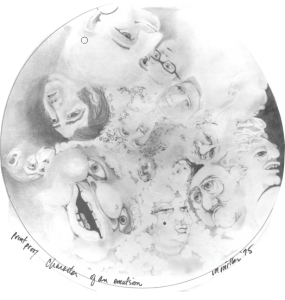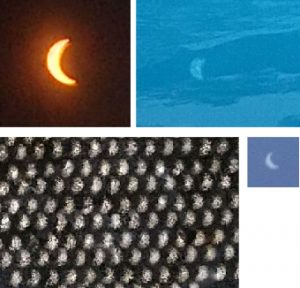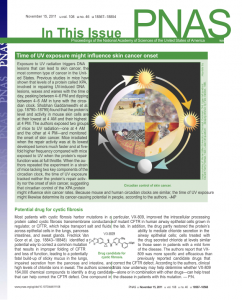OK so this is tongue-in-cheek. But actually during my stay in the laboratory of Leland Clark, Jr, who was pioneering the blood substitute thing using perfluorochemicals I must have been slightly overcome with the topic, as i sketched out all the characteristics of an emulsion in this “face” montage, in which you can see some familiar icons, including the face of Leland Clark, Jr. (upper right with the mutton chops), and some lab techs, and animal room techs, and even postdocs and the iconic Mr. Clean and an experimental monkey (lower left).![]() Forgive–for posting this drawing some 45 years after it was made.
Forgive–for posting this drawing some 45 years after it was made.
Category Archives: Science and art cover illustrations
E2 lysosome “Looking at U”
Could not help but post this cute little lysosomal structure in a macrophage of a mouse that liquid breathed E2 (see previous posts for chemical structure) for 3 hours and was allowed to recover for 48 hours. This lysosome is a tiny portion of an electron micrograph of a macrophage in the alveolar space of the lung.
The scope of lysosomal variation in these macrophages is really quite astounding. I see lysosomes with a tiny bit of enzyme material localize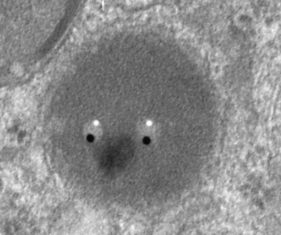 d on one side of the membrane bound structure, and others, like this, with maybe 4 or so tiny perfluorocarbon droplets (which looked like two eyes to me), and massive amounts of enzyme (all that medium grey in a round membrane structure). A library of these variable organelles is what I am attempting to do at this point. E2 is capturing my attention. If you look closely, around the periphery of the lysosome there are small circular areas, which I have no doubt are the tiniest lysosomal droplets down around the size of 20-30nm in diameter. The “eyes” that are droplets here are much larger than that, closer to 100-200nm). Highlight in the eyes and the dark pupil i did in photoshop just to have fun, but the eyeball itself is E2 and the “nose” is enzyme density. In the upper left corner of the image there is another lysosome with a round E2 droplet (about 75nm diameter) with some layered darker substructure.
d on one side of the membrane bound structure, and others, like this, with maybe 4 or so tiny perfluorocarbon droplets (which looked like two eyes to me), and massive amounts of enzyme (all that medium grey in a round membrane structure). A library of these variable organelles is what I am attempting to do at this point. E2 is capturing my attention. If you look closely, around the periphery of the lysosome there are small circular areas, which I have no doubt are the tiniest lysosomal droplets down around the size of 20-30nm in diameter. The “eyes” that are droplets here are much larger than that, closer to 100-200nm). Highlight in the eyes and the dark pupil i did in photoshop just to have fun, but the eyeball itself is E2 and the “nose” is enzyme density. In the upper left corner of the image there is another lysosome with a round E2 droplet (about 75nm diameter) with some layered darker substructure.
It is possible that part of the lysosomal material here is unique to lung since alveolar macrophages (which this is) tend to uptake surfactant in large quantities, and it seems that some of this lipid material (perfluorocarbons have different lipid solubilities, and this might contribute to the mixture of electron dense (osmiophilic) nature of the lysosomes. I might call these MVE/LE/PFC, but that is too cumbersome, hence forth, just lysosome. Besides the specific proteins and enzymes and pH in these structures has not been measured in this archival material… thus there is no way to accurately classify them so I will call them lysosomes.\
90% Solar eclipse in Cincinnati: 8 21 2017
Lysosomes, diagrams, hysterical typo
 I hope I am able to laugh at my mistakes, as this individual needs to laugh at their typo. What… ha ha… a lysosomal rapture…. no kidding, waiting for the rapture myself, and hoping to be among those taken into the ether. Just in case you missed it…. lysosomal rupture would be, i must presume, what was intended.
I hope I am able to laugh at my mistakes, as this individual needs to laugh at their typo. What… ha ha… a lysosomal rapture…. no kidding, waiting for the rapture myself, and hoping to be among those taken into the ether. Just in case you missed it…. lysosomal rupture would be, i must presume, what was intended.
Perhaps this book chapter is source of the “rapture”
E2 liquid breathing: no joke
I really am fond of being silly, particularly when images like this hungry alveolar macrophage with eye and open mouth show up in my files. I probably took this image for my archives on liquid breathing way back in the late 1970s, never seeing the humor in the anatomy. But this morning when I was trying to figure out how to post this image, i just laughed out loud to see the perfect eye and open mouth and could not resist adding a “big mack” and “eyeball” with photoshop. The original, actual serious micrograph is below the cartoon.
So here is an alveolar macrohage, in a pretty good looking alveolus, from a mouse which was dunked in E2 for three hours (bubble oxygenated) and survived and was allowed to recover for 17 days. The pattern for E2 clearance from the lung is a little unique in that the droplets of perfluorocarbon are neatly coalescing into bigger and bigger droplets in some instances, but in others are seen as small droplets within, what i used to call “black cap lysosomes” which were apparently lysosomes with dense collections of enzymes, pushed over to one side of the organelle. Thus is was assumed the perfluorocarbon droplets became part of the lysosomal pathways. The E2 droplets here are white, I did not pseudocolor them as in the previous post, I did remove three pieces of junk using the stamp tool in photoshop. In this case the “eye” or “eyeball” seen for real in the bottom images is likely a tangential section of a medium size E2 droplet just pressing in on the nucleus making a symemtrical indentation. It does not have the character of a nucleolus, which the other option would be. The mouth of the cartoon was a reasonably large droplet of E2 (before i filled it in with big mack) probably on the order of 3-4 microns in the observed diameter. The tiniest droplets of E2 can be seen here and there in the cytoplasm, some of them even less than 0.5 microns in diameter. Mitochondria in these macrophages do not seem to be stressed by the presence of E2 droplets (more or less confirming their alleged inertness) and the amount of nuclear condensed chromatin would also suggest that the macrophages are not activated by E2 since there seems not to be any ramped up RNA, ribosomal, synthesis in the nucleus, or protein synthesis in the cytoplasm, which would suggest an increased synthetic activity related to an immune response to the presence of E2.
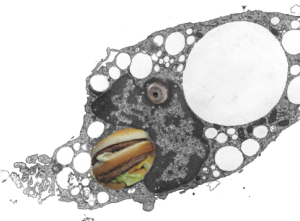 And here is the scientifically sound, non cartoon, image.
And here is the scientifically sound, non cartoon, image.
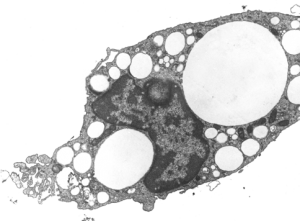 Here is an image with four droplet or droplet groups which show the lysosomal enzymes highlighted in red. These observations relate to perfluorochemicals and fluorochemicals in general as the ability of the body to rid itself of them (whether through outgassing through the lungs reportedly in some relations to the vapor pressure and lipophilicity, and molecular weight. Other elimination is not reported to exist since perfluorochemicals are supposedly not metabolized, so metabolic degradation may not play a role here. I appears that how well the lysosomes “re-emulsify” the droplets is also relevant. Case in point for FC47… it really never was successfully re-emulsified, as opposed to perfluorodecalin which made nice progress in the process of forming tiny droplets in pretty uniform size during elimination. Here you can see the even roundness and lack of droplet substructure and marginalization of the lysosomal enzymes — all important characteristics of the lesser-evil perfluorochemicals.
Here is an image with four droplet or droplet groups which show the lysosomal enzymes highlighted in red. These observations relate to perfluorochemicals and fluorochemicals in general as the ability of the body to rid itself of them (whether through outgassing through the lungs reportedly in some relations to the vapor pressure and lipophilicity, and molecular weight. Other elimination is not reported to exist since perfluorochemicals are supposedly not metabolized, so metabolic degradation may not play a role here. I appears that how well the lysosomes “re-emulsify” the droplets is also relevant. Case in point for FC47… it really never was successfully re-emulsified, as opposed to perfluorodecalin which made nice progress in the process of forming tiny droplets in pretty uniform size during elimination. Here you can see the even roundness and lack of droplet substructure and marginalization of the lysosomal enzymes — all important characteristics of the lesser-evil perfluorochemicals.
Little green aliens among us
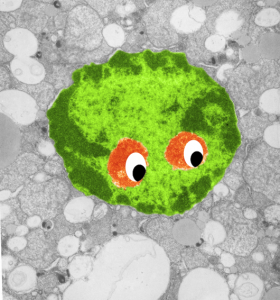 So sorry, ha ha, but when i see this kind of nuclear symmetry (an electron micrograph, with two little presumptive eyeballs staring at me (condensed chromatin), zygomatic arches coming off (as condensed chromatin on the sides of the nucleus), and a hairline part at the center of the frontal bone (condensed chromatin and nuclear pores on the inner nuclear membrane at the top of the nucleus) and a pointy chin, I am compelled to laugh out loud and add this to my collection of TEM-Devils, and sometimes other objects like hearts and ghosts and snowflakes. Anyway, here is a little green cutie, which spawns from a mouse hepatocyte null for 14CoS and not receiving NTBC as a “saving” medicine and prone therefore to undergo massive hepatocytic apoptosis within a day or so of birth, and ultimate demise. This mouse is 24 hours post partum and showing signs of hepatocyte apoptosis, and mitochondrial and ER disarray, neg 16042, block 65718, anm#5, one chatter line removed with photoshop, layers constructed in photoshop, pseudocolor and eyes added in CorelDRAW. Dont you wish there was a place to publish such stuff…. Maybe i will start my own journal… help me think of a name. (LOL)
So sorry, ha ha, but when i see this kind of nuclear symmetry (an electron micrograph, with two little presumptive eyeballs staring at me (condensed chromatin), zygomatic arches coming off (as condensed chromatin on the sides of the nucleus), and a hairline part at the center of the frontal bone (condensed chromatin and nuclear pores on the inner nuclear membrane at the top of the nucleus) and a pointy chin, I am compelled to laugh out loud and add this to my collection of TEM-Devils, and sometimes other objects like hearts and ghosts and snowflakes. Anyway, here is a little green cutie, which spawns from a mouse hepatocyte null for 14CoS and not receiving NTBC as a “saving” medicine and prone therefore to undergo massive hepatocytic apoptosis within a day or so of birth, and ultimate demise. This mouse is 24 hours post partum and showing signs of hepatocyte apoptosis, and mitochondrial and ER disarray, neg 16042, block 65718, anm#5, one chatter line removed with photoshop, layers constructed in photoshop, pseudocolor and eyes added in CorelDRAW. Dont you wish there was a place to publish such stuff…. Maybe i will start my own journal… help me think of a name. (LOL)
Love in any language
Totally unnecessary post of bone marrow nuclei: but what it says very clearly is that symmetry prevails, may not be the symmetry we expect from a set of identical chromosomes all lined up in on-off status, both sides the same (X chromosome or barr body excepted). I see here a great symmetry, right to left mirror, top to bottom asymmetry, pointy at the bottom because this is an area where the nuclear membrane might just get segmented into a thin band between two bottom areas of chromatin…. going from what might appear to be a point, to two cheeks.
I am thinking about writing up an editorial on this symmetry…. make the cover submission first, always my motto. Each of the hearts below is from bone marrow from an hypoplastic animal (CyP1a1null) either given benzo(a)pyrene or control diet. These particular nuclei are not yet hypersegmented… just fun examples of symmetry, which i have outlined in an identical micrograph below this.

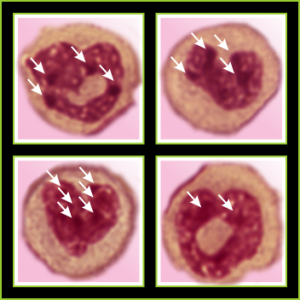 So there is symmetry, it is bilateral in one dimension, but will take some thinking to see how to describe a third dimension in symmetry.
So there is symmetry, it is bilateral in one dimension, but will take some thinking to see how to describe a third dimension in symmetry.
Because the chromosome territories likely (per published data) kind of interdigitate, most assuredly, at many sites along each chromosome for functional reasons) the symmetry will be highly simplified in light micrographs at best.
All this discussion could lead to a place to examine the chromatin patterns in the X (barr body) in neutrophils where they are hanging on by a nuclear membrane thread – so to speak) and other parts of the neutrophil nucleus where transcriptional activites are going on.
Ferret alveolar type II cell TEM: pseudo-colored
Inside cover for PNAS
I completely forgot about this diagram which I think i really wanted as a front cover for PNAS, but for some reason it was accepted as an inside cover. This is a cool biological clock done for Aziz Sancar. I feel pretty honored that they actually put my name on this, along with my attributions to the various historical paintings. I will post an image with more detail as well.
66 names for the devil
This post is just for fun, as when i was looking at some electron micrographs of the Gclc mouse liver study I found this critter, just with big eyes (one of which i added the pupil to using photoshop — my apologies) but otherwise not retouched. The exact data are neg17894_block74138_animal706_wcii_NAC. Initially I was interested in the nucleoli, but naggingly amazed about the “devil” appearance of the nucleus as a whole.
Color was of course added using photoshop, all else remains the same. When considering what to call this character i googled “names for satan” and behold, the list of about 66 names from various cultures and groups showed up (cut and pasted from Wikipedia (thank you wikipedia) (below).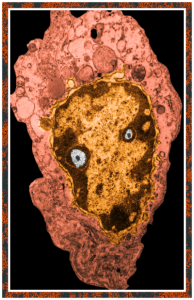
Abaddon—(Hebrew) the destroyer
Adramalech—Samarian devil
Ahpuch—Mayan devil
Ahriman—Mazdean devil
Amon—Egyptian ram-headed god of life and reproduction
Apollyon—Greek synonym for Satan, the arch fiend
Asmodeus—Hebrew devil of sensuality and luxury, originally “creature of judgment”
Astaroth—Phoenician goddess of lasciviousness, equivalent of Babylonian Ishtar
Azazel—(Hebrew) taught man to make weapons of war, introduced cosmetics
Baalberith—Canaanite Lord of the covenant who was later made a devil
Balaam—Hebrew devil of avarice and greed
Baphomet—worshipped by the Templars as symbolic of Satan
Bast—Egyptian goddess of pleasure represented by the cat
Beelzebub—(Hebrew) Lord of the Flies, taken from symbolism of the scarab
Behemoth—Hebrew personification of Satan in the form of an elephant
Beherit—Syriac name for Satan
Bilé—Celtic god of Hell
Chemosh—National god of Moabites, later a devil
Cimeries—Rides a black horse and rules Africa
Coyote—American Indian devil
Dagon—Philistine avenging devil of the sea
Damballa—Haitian Vodou serpent god
Demogorgon—Greek name of the devil, it is said should not be known to mortals
Diabolus—(Greek) “flowing downwards”
Dracula—Romanian name for devil
Emma-O—Japanese ruler of Hell
Euronymous—Greek Prince of Death
Fenriz—son of Loki, depicted as a wolf
Gorgo—dim. of Demogorgon, Greek name of the devil
Haborym—Hebrew synonym for Satan
Hecate—Greek goddess of the underworld and witchcraft
Ishtar—Babylonian goddess of fertility
Kali—(Hindu) daughter of Shiva, high priestess of the Thuggees
Lilith—Hebrew female devil, Adam’s first wife who taught him the ropes
Loki—Teutonic devil
Mammon—Aramaic god of wealth and profit
Mania—Etruscan goddess of Hell
Mantus—Etruscan god of Hell
Marduk—god of the city of Babylon
Mastema—Hebrew synonym for Satan
Melek Taus—Yezidi devil
Mephistopheles—(Greek) he who shuns the light, q. v. Faust (Greek)
Metztli—Aztec goddess of the night
Mictian—Aztec god of death
Midgard—son of Loki, depicted as a serpent
Milcom—Ammonite devil
Moloch—Phoenician and Canaanite devil
Mormo—(Greek) King of the Ghouls, consort of Hecate
Naamah—Hebrew female devil of seduction
Nergal—Babylonian god of Hades
Nihasa—American Indian devil
Nija—Polish god of the underworld
O-Yama—Japanese name for Satan
Pan—Greek god of lust, later relegated to devildom
Pluto—Greek god of the underworld
Proserpine—Greek queen of the underworld
Pwcca—Welsh name for Satan
Rimmon—Syrian devil worshipped at Damascus
Sabazios—Phrygian origin, identified with Dionysos, snake worship
Sammael—(Hebrew) “venom of God”
Samnu—Central Asian devil
Sedit—American Indian devil
Sekhmet—Egyptian goddess of vengeance
Set—Egyptian devil
Shaitan—Arabic name for Satan
Shiva—Hindu the destroyer
Supay—Inca god of the underworld
T’an-mo—Chinese counterpart to the devil, covetousness, desire
Tchort—Russian name for Satan, “black god”
Tezcatlipoca—Aztec god of Hell
Thamuz—Sumerian god who later was relegated to devildom
Thoth—Egyptian god of magic
Tunrida—Scandinavian female devil
Typhon—Greek personification of Satan
Yaotzin—Aztec god of Hell
Yen-lo-Wang—Chinese ruler of Hell
